Aside from birdwatching being an exciting activity, it also helps us learn more about various species. Birds are diverse creatures, so identifying them would be easiest if you know what to look for, like patterns or behaviors.
Birding would be more fun if you could recognize those birds with red head frequenting your backyard feeders. Mastering bird recognition requires patience in becoming familiar with different field marks, including colors.
With that in mind...
Let's go over what birds have a red head and their myriad profiles. It will make you more confident of naming the birds visiting your garden.
Different Birds With Red Heads
Familiarization with a bird's different colors and markings can help recognize it. There's so much fun when you know precisely that brown bird with a red head you saw while walking or driving or when you are actively bird watching.
Here are some of the birds with their field marks and profiles to help make red head bird identification a lot more effortless for you:
1. House Finch
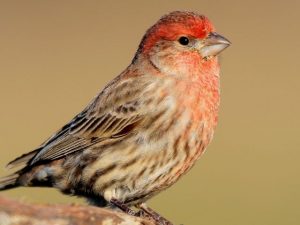
House finches have short, rounded wings that can flutter through dense branches. A male house finch has notable brown-streaked chests beside the brick red shade of its head and bib.
Many often mistake this bird for a purple finch when people see it in a finch feeder. However, you can distinguish one from the other with the latter's pointed crown. Its face and neck have more red than adult male house finches with some brown markings on their faces.
Furthermore, as its name implies, this finch is comfortable nesting and feeding in suburban areas. Sadly, some nasty conjunctivitis caused a severe decline in this bird's population in the Eastern part of the United States.
2. Red-Headed Woodpecker
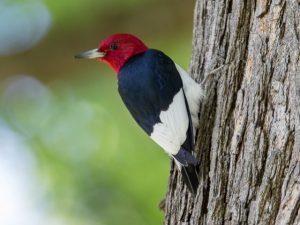
It's a black and white bird with red head and neck, white breast, and bluish-gray bill. The juveniles differ with their pale brown and white plumages and slight reddish blush on their foreheads.
Sometimes, you would see this bird in a contentious altercation with the Lewis woodpecker and acorn woodpecker. These birds would fight over fruit, nuts, and acorns stored in tree-bark crevices.
Like the red-bellied woodpecker, a black bird with a red head, it's likewise a mid-sized bird inhabiting various wooded habitats, plantations, oak savannah, and orchards. You may expect a red-headed woodpecker to join large flocks when traveling along the coast.
While mainly a resident of the northern population, this woodpecker moves south in winter, although some migrate depending on the accessibility of food sources.
3. Hairy Woodpecker
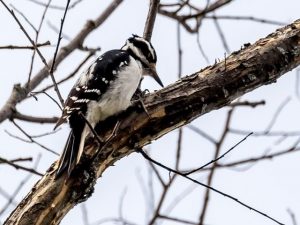
Both are familiar visitors to bird feeders, especially a well-stocked suet feeder. So if by any chance you have both of these similar-looking birds in your yard, you can tell them apart with the hairy's more prominent, longer bill.
Aside from these birds having distinct vocalizations, the Hairy's drumming sounds faster than the Downy's. Compared to a Downy, it has a lower and louder pitch. Moreover, this resident of the northern hemisphere tends to move southbound in winter.
The Hairy has a white underside, white spots on its black wings, grey legs, and a distinctive pattern of black and white on its face. It resides in mature woodland areas, suburban parks, and swamps. Insects and their larvae, also some nuts and seeds, are part of its diet.
If you find this or other woodpecker's hammering activity a nuisance or destructive to your property, it's best to report the incident to wildlife services. Don't merely attempt to get rid of it without checking if it's on the list of species protected by the Migratory Bird Treaty Act.
You have to find out the species' scientific name so that you can check if it's on the protected species list. Or you may also do a quick search from the list of endangered species.
4. Cassin’s Finch
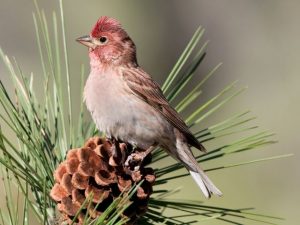
The bird is a casual winter visitor in western and central Texas. Bird sighting reports showed that the Cassin's appeared in the state from early November to mid-February.
Its male has a rosy red crown, neck, and throat, with a bright pinkish-red crown highlighting the pale-looking nape and streaked back. On the other hand, the female has brown, streaked upperparts, white underparts, and crisp streaks on the breast.
Cassin's finches like joining small flocks and mainly dwell in pine forests. Although, it would rather stay in lowland deciduous regions during winter. The bird enjoys feeding on alders, conifers, birches, grasses, and buds.
5. Pileated Woodpecker
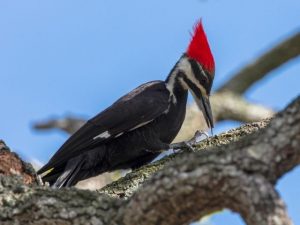
This woodpecker safeguards its breeding grounds throughout the year and will not leave territory even after its mate dies. It is North America's most sizable woodpecker and has powerful bills that hammer nesting cavities effortlessly.
Its call resembles a crazy laugh, which inspired the famous Woody Woodpecker cartoon character. You might mistake the sound for one coming from a flicker, except that it sounds wilder and more enthralling.
Additionally, pileated woodpeckers prefer to inhabit mature forests where a watercourse or a standing dead tree are nearby. These birds are also adaptable to human neighborhoods where bird houses and food sources are readily available, so don't be surprised to find this crested bird making its home next to yours.
6. Northern Cardinal
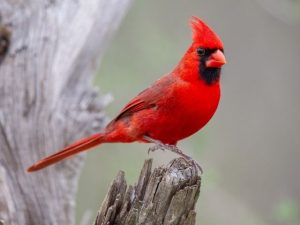
Its striking red plumage with a black throat patch extending to the neck is a familiar sight in the eastern part of the United States. This eye-catching creature is unmistakable for its bright color, prominent crest, and honking red bill.
While its kind would willingly visit a backyard feeder in winter, this bird also frequently inhabits suburban and edge habitats, city parks, and moist forests. It cannot resist a hopper-style feeder full of black oil sunflower seeds.
The male Northern cardinal is well-known for its aggressive behavior, attacking its reflection from windows or glossy surfaces. It's typical to encounter mated pairs becoming extremely territorial in protecting their nest from rivals.
7. Scarlet Tanager
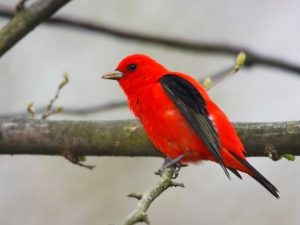
It has darker wings than the summer tanager, with a gray bill and black, button-like eyes. When it goes through seasonal changes, the bird's plumage will molt into a faint olive shade and yellowish underparts.
The western part of North America also has the Western tanager; also a red-headed bird with a yellow body and black wings.
This tanager displays a strong preference for woodlands with abundant oak trees or treetops from backyards. It mainly eats insects; hence, if you want to attract this red bird in your garden, you might as well feed it with mealworms. You can also have some berry-producing plants.
You are lucky if you chance upon some of its kind that willingly eats a peanut butter–cornmeal mixture, orange halves, doughnuts, and bread. But to be sure, setting up a water-filled birdbath would make your backyard irresistible to this tanager.
Watch this video footage of a Scarlet Tanager:
8. Vermilion Flycatcher
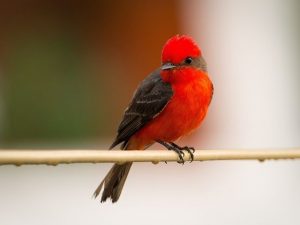
Females look pretty dull compared to adult males, with vibrant red and brown plumages. Despite having different structures, some find it comparable to a scarlet tanager, except that the latter lacks a dark back and mask.
It's a summer resident in Hill Country State Natural Area in Texas, but you can find this flycatcher inhabiting open habitats during the breeding season. Moreover, you may encounter this flycatcher performing a spectacular courtship display when mating.
Vermillion flycatchers dwell in urban neighborhoods or isolated houses. But they prefer open woodlands with nearby water in winter. The bird is primarily an insect-eater, often catching flying insects while perching.
9. Pine Grosbeak
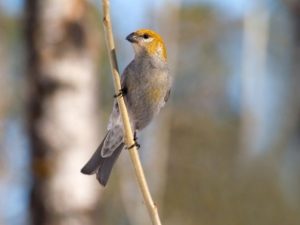
The Upper Midwest is home to pine grosbeaks in winter. Otherwise, it will breed in boreal forests in the North or coniferous and rain forests in Alaska. This bird has an unpredictable migration route like other northern finches.
Moreover, it is not unusual to find male and female grosbeaks displaying territorial behavior during the breeding season. These birds will undoubtedly defend their territory from anyone who attempts to invade it.
You can identify this grosbeak with its pinkish-red crown, curved, blackish bill, long tail, and black eyes. Its underparts are also pinkish-red, but this could vary per region.
Pine grosbeaks strongly prefer well-hidden nests, like in hollow trees, far from humans or predators. It forages for insects and seeds but enjoys gorging on a ripe fruit all the more. You are likely to spot this bird likes in wooded regions near streams and ponds.
Frequently Asked Questions
What birds have a red head in North America?
North America has many brightly colored birds, some of which have striking red crowns. These red-headed birds are likely to be woodpeckers, tanagers, redpolls, or Northern cardinals. It is common to find woodpeckers in North America, and some of them have red crowns.
Throughout much of the United States, you can find two types of tanagers with red heads; the common redpoll and Arctic redpoll have prominent red caps.
The northern cardinal is a familiar bird that is entirely red. Birders can find it in North America, South America, and parts of Mexico. The redhead is a mid-sized diving duck with a brick-red crown and neck.
The barn swallow might appear to fit the description of birds with red heads because its forehead has a chestnut shade which some mistake for red. It's also the same thing for the colorful painted bunting since only its underparts are red.
What are the finches with red-colored heads?
There are several kinds of finches having red crowns. You can even find some of these finches in the United States. The house finch is the most common and famous to many birders, given that it is a native bird in the western part of North America.
Of course, let's not forget the Cassin's and purple finches also have red-colored heads. While a unique kind, the red crossbill, more common in Central America, has a red to orange head color. Lastly, there's the red-headed finch, which is a common bird in South Africa.
What red-headed birds have brown bodies?
The house finch is a small bird with a redhead and brown body, and so is the red-headed finch. The latter has a grayish-brown, boldly barred body with a bright red crown. Even a lesser redpoll has a deep red cap and pale brown underparts.
Final Thoughts
It's less complicated to identify some birds than others, but species identification can be challenging in many cases. Color and pattern diversity can also result from the altered light-reflective properties and iridescence in feather structures, as in hummingbird feathers.
There are instances when birds belonging to a species do not look alike. Adult males and females often have varying colors, and even the young birds look different from the adults. Some birds have plumages that go through seasonal changes.
At least through this birding guide, you have better chances of acing that red head bird identification. Being well-acquainted with bird anatomy will enhance your identification skills.
You will understand how our feathered friends function and make birdwatching a fun, learning endeavor.